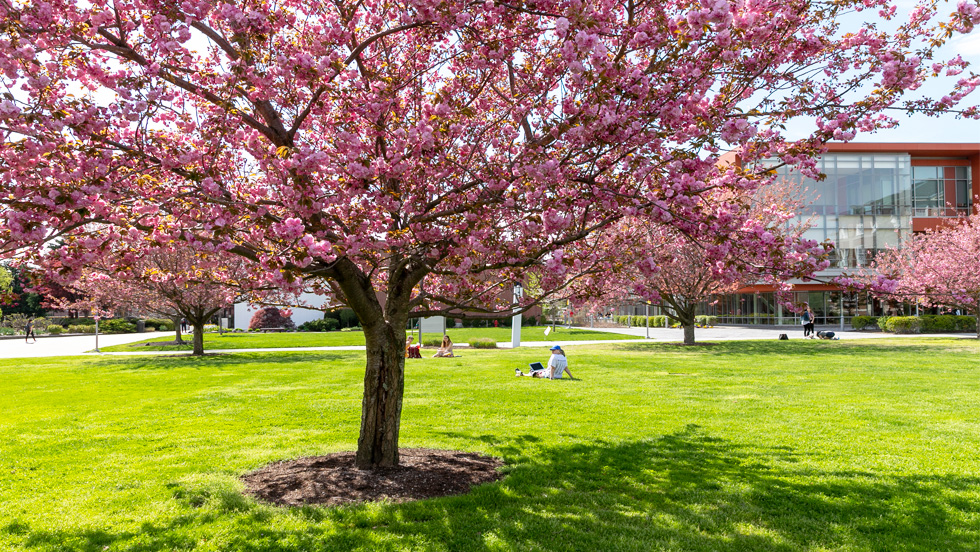
Get ready for the many cherry trees and other flowering trees on campus to peak in the next few weeks. Learn what species we have, where to find them and how Adelphi keeps them blooming.
Spring is arguably the prettiest season on campus. It’s when our many flowering trees, most notably, the cherry trees, burst into bloom. But what types of cherry trees can we see, who cares for them and how do they keep them in top form? To find out, we spoke with Bob Conaghan, associate director of facilities.
According to Conaghan, two varieties of Japanese cherry trees, which vary in size and age, grace the campus. The majority are Kwanzan cherry trees, with deep pink blossoms that pleasantly contrast with the white to paler pink shades of the Yoshino trees.
The cherry trees that have been planted along the baseball field are informally referred to by Conaghan’s grounds crew as “cherry lane,” he reported. The trees start blooming in mid-April. The Kwanzan (prunus serrulata) cherry trees in front of the Ruth S. Harley University Center are a favorite spot for grads to pose in their caps and gowns.
Conaghan, whose career at Adelphi began 44 years ago, recalled a time when there was a single surviving black cherry tree—prunus serotina—by the Hy Weinberg Center. Unlike the Kwanzan and Yoshino blossoming trees, black cherry trees are native to Long Island and bear fruit.
Meet Some Other Trees
For those eagerly awaiting the peak of the cherry trees’ blossoms, Conaghan noted that the Cornelian cherry dogwoods, which he planted a few years ago on South Avenue and between the Nexus Building and Swirbul Library, are always the first trees to bloom on campus with their lovely yellow flowers. “It’s not a cherry tree, despite its name, but does have beautiful early blossoms.”
He pointed out a native Long Island tree called an eastern redbud (Cercis canadensis) by Hagedorn Hall that bursts into purple-hued flowers in May. “Walk from the UC to Nexus and you’ll see a purple-leaf flowering plum tree on your left,” he noted. “We also have a few different types of magnolias that are also getting ready to bloom. One of my favorites, on the south side of Levermore Hall, is the cucumber magnolia, with its pretty yellow flowers.”
TLC for Cherry Trees
Caring for the cherry trees is relatively straightforward, Conaghan said, adding, “Pruning is important to keep a tree’s crown in shape. And they don’t like to be overwatered.
“We have a good system here, though,” he explained. “When I took over the grounds, I threw out all pesticides and began an organic practice. We bring in insects such as assassin bugs and green lacewings to eat insects we don’t want. We engage in proper pruning and watering—which all seem to be working to keep the trees in good shape.”
Like all living things, however, the ornamental cherry trees have a lifespan. “Some of the older ones have been here for 70 years—but they won’t last forever,” Conaghan said.
That’s why “We continue to plant more cherry trees on campus. We like variety, but we mainly look for what is healthiest at local nurseries. If Kwanzan trees look healthier than Yoshino trees, we’ll get them—or vice versa.”
Boots on the Grounds
Conaghan’s grounds crew of four is led by foreman Jimmy Campbell, who is “a miracle on two feet,” Conaghan said. Beginning at 6:30 every morning, the crew polices the entire campus, not only cleaning up garbage, but also inspecting the shrubs, trees, flowers and grass. This daily check ensures that any problem—whether aphids in a tree or a lawn that is turning brown—is taken care of without delay and unnecessary expense.
“We don’t want plants to die on our watch,” Conaghan insisted. “And we want our beautiful campus and arboretum to look the best it can. I’m not the one responsible for how nice the campus looks. The grounds crew is. These fantastic guys have a great knowledge of plants, flowers, trees. They make my job easy.”